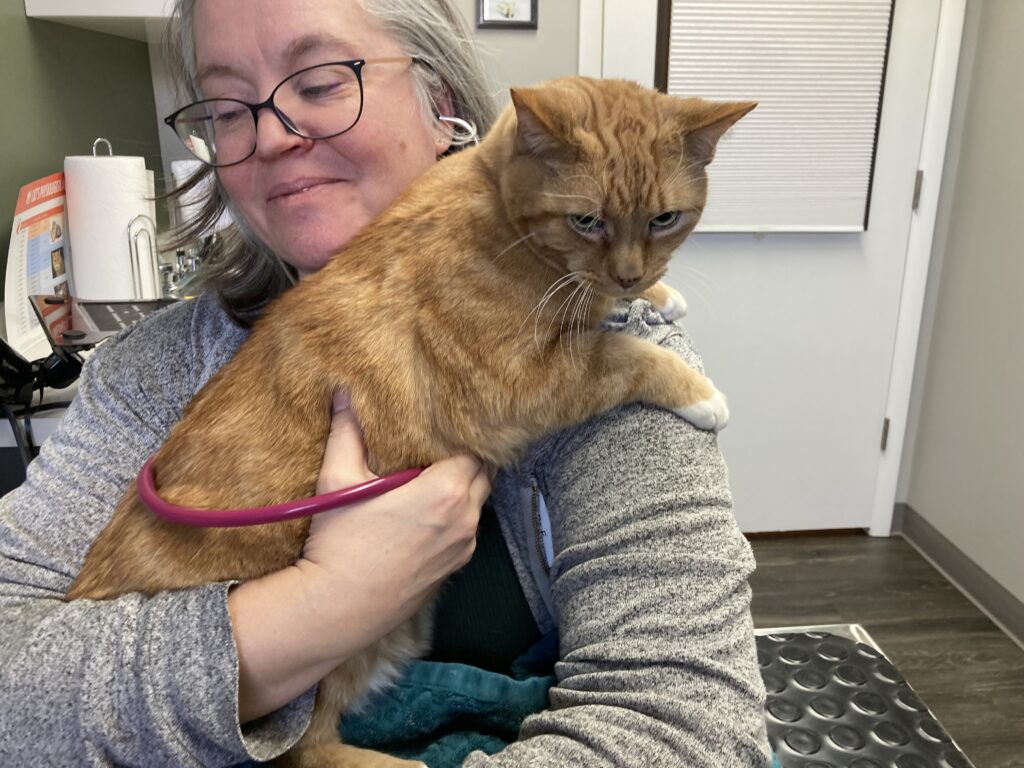
What can your cat expect at her veterinary exam? The typical exam starts at the head and works through the body to the tail. This way health vitals are systematically collected. But it is important that the feline practitioner pay attention to the individual cat. For example, if your kitty seems to have pain in her mouth, in the cat friendly exam the vet may work through the rest of the exam first, and address the possibly painful mouth last. Saving the worst for last keeps your cat from anticipating pain throughout the entire exam.
Cats prefer high-intensity interactions that don’t last long. So, your cat may be offered a break between parts of the exam. Your cat may enjoy treats, toys, or gazing out a window during these breaks.
The Cat friendly Exam
Auscultation of the chest
Here your vet “listens” to your cat’s heart and lungs, measuring a heart rate and respiration rate in addition to noting abnormal heart rhythms (eg. heart murmur) and abnormal breathing sounds (eg. congestion). The vet typically will approach the cat from the back or side and use a stethoscope.
Head and Neck examination
Parts of this exam may happen even before your cat is on the exam table. Head tilts and facial swellings can be observed from a distance while your cat is walking around the room. In the more hands-on part of this exam, your vet may use an ophthalmoscope or otoscope to check the eyes and ears. He or she will also raise your cat’s lips to get a look at her teeth and open her mouth to check the oral cavity and get a quick look under her tongue.
Abdominal Palpation
In this part of the exam, the vet massages your cat’s belly to feel her intestines, kidneys, and bladder. It is also a check for possible growths in the abdomen and thickened walls in the intestines and bladder.
Back and limb assessment
This part of the exam includes assessment of the muscles along the spine and legs. The paws will also be evaluated and the claws extended.
Under the Tail Check
A quick look under the tail for fecal debris, swelling, and discharge… completes the exam.
Reference: “2022 AAFP/ISFM Cat Friendly Veterinary Interaction Guidelines: Approach and Handling Techniques”, Rodan et al., Journal of Feline Medicine and Surgery, Volume 24, Issue 11, November 2022, Pages 1093-1132
the cat friendly exam: practice at home
Some of the handling your cat may encounter at his vet visit includes being lifted up onto an exam table, getting weighed on a scale, sitting on an exam table to have his chest auscultated, having his head and mouth examined, and having his back and legs massaged and handled.
You can practice some of the cat friendly exam handling with your cat at home. Training some basic behaviors such as “pick up“, “sit” and “target” can make this a pleasant experience for you and your cat.
First – choose an area at home where you will train
Pick a table, counter, or dresser (avoid the kitchen table or counter) where you can set up your “exam room”.
You can purchase a baby scale to weigh your cat if you want to monitor his weight or just get the bathroom scale and place it on your counter. The weight from the bathroom scale will not be accurate but your cat will have the experience of getting on a scale.
Fast Forward…
Let’s say you have trained your cat to be picked up, to sit and to target. Your practice vet visit at home may go something like this:
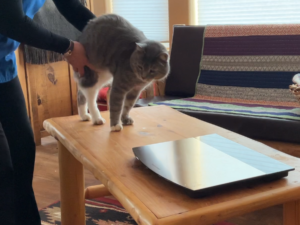
Give your cat the “UP” cue and gently lift him (support his front and back body) and place him on the counter. Make sure to reward him (treats, head rubs…).
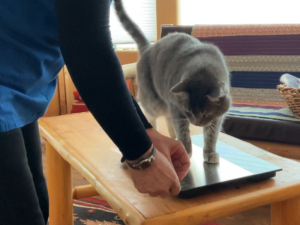
Once on the counter, use your target stick or finger, to guide him to walk over to the scale and climb on it. Once he is on the scale, ask him to “Sit”. Reward him when he sits.
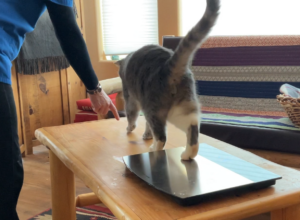
Next, ask him to get off the scale using the target stick or your finger and have him sit on the counter.
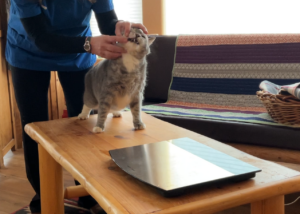
Approaching him from behind, rub his head and hold it gently. Work up to lifting his lip to view his upper teeth. Reward and repeat on the other side.
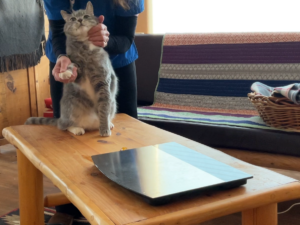
To evaluate his feet, massage each foot, gently extending his claws – reinforce cooperative behavior with a reward.
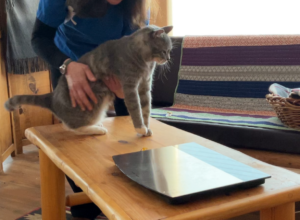
Give your cat the pick up cue, and gently put him back on the floor. Reward him for a job well done!
It does take some time to train your cat to be picked up, sit, and target and combine these behaviors as outlined above. And – unless your cat is used to performing away from home – he may not go through his home routine at the vet clinic, especially if he is being handled by strange people. But the handling in the cat friendly exam will be familiar due to his practice exams at home and should not trigger him to engage in protective or defensive behaviors.
Cats that are used to being handled do not get as stressed and anxious as those who are only handled occasionally. A cooperative cat needs little or no restraint and can often be examined by one person. Make sure you let your vet know which behaviors your cat is familiar with and what the cue is for each one.

